North Texas Wild: Spring Creek Forest preserves ‘biological museum’ in Garland
The 200-acre Spring Creek Forest Preserve features ancient trees, fossils and rich plant life.
by Amy Martin
Feb. 8, 2017
 The towering aged trees along Spring Creek are visible to thousands of people from the parking lots of the nearby big box sports store, water park, convention center and a handful of schools. Few pay attention. Just another riparian corridor spared from development by being too rugged or flood-prone.
The towering aged trees along Spring Creek are visible to thousands of people from the parking lots of the nearby big box sports store, water park, convention center and a handful of schools. Few pay attention. Just another riparian corridor spared from development by being too rugged or flood-prone.
So the incurious don’t realize that these chinquapin, bur and shumard oaks that grow here are found together nowhere else in the world. That some trees are more than 100 feet tall with trunks four feet across, and it takes 100 to 300 years for trees to get that massive. Settlers logged most of the Spring Creek riparian corridor, but this part benefitted from protection by the primary landowner, the family of Anne C. Weary, an established artist who counted on the woods as inspiration for many artworks. Spring Creek’s steady flow, and the occasional bank-jumping flood, kept the soils moist and the trees healthy, allowing for steady, strong growth.
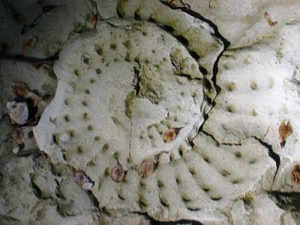 A shallow, sun-warmed ocean covered much of Texas some 87 million years ago. The fossilized bodies of minuscule water creatures accumulated by the billions to form the flakey, white Austin Chalk limestone of North Texas. Over millennia, Spring Creek eroded through layer after layer, creating pale cliffs 20 yards deep or more. The wooded lowlands flanking it are rife with downed trees and brush piles, pushed against bases of larger trees by Spring Creek’s fierce flow during floods.
A shallow, sun-warmed ocean covered much of Texas some 87 million years ago. The fossilized bodies of minuscule water creatures accumulated by the billions to form the flakey, white Austin Chalk limestone of North Texas. Over millennia, Spring Creek eroded through layer after layer, creating pale cliffs 20 yards deep or more. The wooded lowlands flanking it are rife with downed trees and brush piles, pushed against bases of larger trees by Spring Creek’s fierce flow during floods.
In the 1980s, Garland resident Bobby Scott and esteemed naturalist Ned Fritz brought the forest’s unique “biological museum” status to officials’ attention. Dallas County and the city of Garland, assisted by the State of Texas, began purchasing acreage along the corridor. The result today is a patchwork of parks and public land called Spring Creek Forest Preserve. It includes the 70-acre Lee F. Jackson Spring Creek Forest Preserve, the 30-acre Spring Creek Park Preserve and Spring Creek Greenbelt: Fred E. Harris Section for a total of about 200 acres.
Citizen Foresters: Friends of the Forest
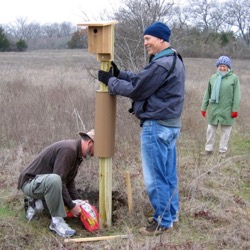 The future of this precious relic forest falls mainly on the shoulders of volunteers at Preservation Society for Spring Creek Forest. Leaders allowed me to tag along on an exploratory hike one warm winter morning. Dana Wilson was our plant pro, answering questions with Master Naturalist expertise. Maureen Bly brought along her intuitive woods wonder and sense of service to the Earth.
The future of this precious relic forest falls mainly on the shoulders of volunteers at Preservation Society for Spring Creek Forest. Leaders allowed me to tag along on an exploratory hike one warm winter morning. Dana Wilson was our plant pro, answering questions with Master Naturalist expertise. Maureen Bly brought along her intuitive woods wonder and sense of service to the Earth.
Volunteers install a bluebird box.
David Parrish, who coordinates Eagle Scout service projects in Garland parks, convened this hike to introduce Andrew Fernandez and his dad Elvis to Spring Creek Forest Preserve’s latest pressing need: a trail through some of the prettiest and best-preserved sections of the woodlands behind the Curtis Culwell Center. A rough trail had been mostly hashed out. The Scout and his father identified the path with marking tape. Along the way, they received tips from the Spring Creek crew on how to widen and prepare the path, which plants the Scouts should favor and which ones to spare, how to account for erosion and other vital considerations.
The Preservation Society for Spring Creek Forest hosts monthly workdays to maintain the trails and monitor the impact of wildlife and weather on the land. Guided walks are a frequent happening. On Saturday, Feb. 25, Tom Frey steps in the late Jim Varnum’s shoes to lead the 24th Annual Trout Lily Walk. The group also hosts monthly meetings at the North Garland Branch Library. On Tuesday, March 7, Janet Smith talks about on “Sex in the Garden.” Evidently, some wildlife is pretty darn wild. On Tuesday, April 4, I’ll speak on “13 Things You Need To Know about Poison Ivy.”
The Plants of Spring Creek
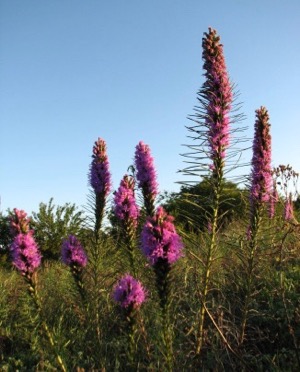 Massive deciduous trees thrive in the generous floodplain soil, a mature forest with trunks spaced widely apart. The understory is lush with roughleaf dogwood whose berries sustain more than 50 species of birds. Nestled among them are shrubs like elderberry with its plethora of strong tall stems and large bundles of teeny white flowers, modest coralberry’s slight arcing stems and wispy teardrop leaves, and the fountain of long arching branchlets weighed down by purple berries that create the beautyberry. This understory allows wildlife to move unseen, turning the riparian corridors into a thoroughfare for animals in search of food and water.
Massive deciduous trees thrive in the generous floodplain soil, a mature forest with trunks spaced widely apart. The understory is lush with roughleaf dogwood whose berries sustain more than 50 species of birds. Nestled among them are shrubs like elderberry with its plethora of strong tall stems and large bundles of teeny white flowers, modest coralberry’s slight arcing stems and wispy teardrop leaves, and the fountain of long arching branchlets weighed down by purple berries that create the beautyberry. This understory allows wildlife to move unseen, turning the riparian corridors into a thoroughfare for animals in search of food and water.
Liatris in late summer.
Spring Creek Forest Preserve is a vision of beauty, the very essence of a nurturing Earth. Golden groundsel is so abundant it carpets the forest with tiny yellow flowers and succulent, round leaves in the spring. Grasses like inland sea oats and Virginia wild rye, with their long, soft, strappy leaves boast nodding golden seedheads in the fall. Tucked in protected places are wildflowers like delicate Solomon’s seal, seen nowhere else in North Texas, the magically ephemeral yellow bell blooms of the trout lily and tiny horsetails that pop up from the soil like diminutive green bottle brushes.
There are also plants that don’t belong in Spring Creek, brought by birds that eat the berries of lawn shrubs like privet, ligustrum and nandina and excrete them in the forest, basically planting them with fertilizer. Parrish described the Big Foot Extractigator tool they’ll be using to pull the roots up from the ground. Wilson showed how to plant the newly disturbed soil with native plant seed gathered nearby.
A Clouded Future for Spring Creek
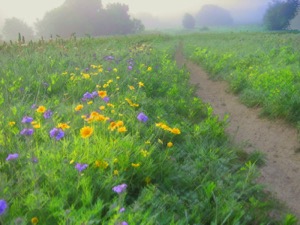 Every day, numbers of people move to newer areas of Garland along the President George Bush Turnpike, which puts pressure on Spring Creek — more development, both industrial and residential. Garland’s park department seems more interested these days in playing fields and manicured parklands, even placing them right up to the creekbank. Purchases of preserve land to complete the wildlife corridor seem unlikely, so the remaining undeveloped acreage in private hands will likely go to developers.
Every day, numbers of people move to newer areas of Garland along the President George Bush Turnpike, which puts pressure on Spring Creek — more development, both industrial and residential. Garland’s park department seems more interested these days in playing fields and manicured parklands, even placing them right up to the creekbank. Purchases of preserve land to complete the wildlife corridor seem unlikely, so the remaining undeveloped acreage in private hands will likely go to developers.
The challenge for Preservation Society for Spring Creek Forest is to persuade nearby residents and business to retain the natural character of the existing preserve. Education that explains how standing dead trees, while unsightly to some, provide essential food and habitat for birds and wildlife. To share that beautiful monarch butterflies require the preserve’s unruly native milkweed plants, that owls in the trees depend on the tall grass which shelters the rodents they depend on for food. That nature, like real life, is messy. That wild lands are needed and need to be wild, even in the city.
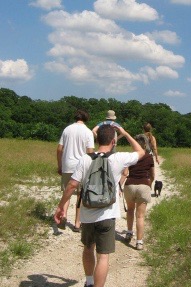 Visiting Spring Creek Forest Preserve
Visiting Spring Creek Forest Preserve
Spring Creek Forest Preserve has two main parking areas: 1787 Holford at Spring Creek Park Preserve and 1770 Holford at Lee F. Jackson Spring Creek Forest Preserve. Lengthier trails are accessible at Lee F. Jackson, but the parking lot and front areas of the park have a problem with anonymous sex hookups. Not dangerous, just irritating and creepy. Once you’re well down the trail, it ceases to be an issue.
Trails at the Spring Creek Park Preserve are expanding. Just last fall was the completion of an Interpretive Walking Trail, made with the help of North Texas Master Naturalists. Thirteen markers along the loop trail post tidbits and wisdom about the ecology of Spring Creek Forest and a small Blackland Prairie parcel.
Spring Creek Forest Resources
Preservation Society for Spring Creek Forest
Lee F. Jackson Spring Creek Forest Preserve
Spring Creek Park Preserve
Spring Creek Greenbelt: Fred E. Harris Section
Stay up to date on everything green in North Texas, including the latest news and events! Sign up for the weekly Green Source DFW Newsletter! Follow us on Facebook, Twitter and Pinterest.
Original post at: http://www.greensourcedfw.org/articles/north-texas-wild-spring-creek-forest-biological-museum-garland





